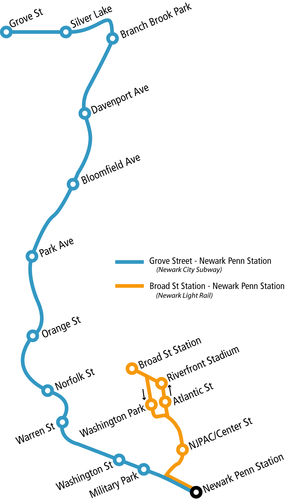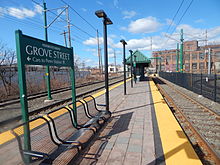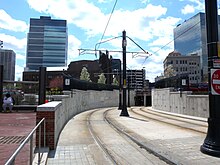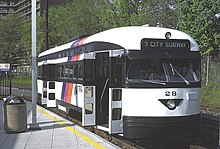Newark Light Rail
| Newark Light Rail | |
|---|---|
| A low-floor - articulated cars on Broad Street Extension | |
| Basic information | |
| Country | United States |
| city | Newark |
| opening | May 16, 1935 |
| operator | New Jersey Transit Bus Operations |
| Infrastructure | |
| Route length | 10.0 km |
| Gauge | 1435 mm |
| Power system | 750 V DC overhead line |
| Operating mode | Bidirectional operation |
| Stops | 17th |
| Tunnel stations | 4th |
| Depots | 1 |
| business | |
| Lines | 2 |
| vehicles | 20 Kinki Sharyo LRVs |
| Route network (as of 2015) | |
The Newark Light Rail is a major mode of transport of the city of the same in the US - State of New Jersey . The system, which consists of two lines, is comparable to the German light railways or their American variant, the light railways , due to the structure of tunnels , trams and routes similar to small trains . Since the two lines are routes that have been opened independently of each other, they also have the names Newark City Subway and Broad Street Extension . It was only with the opening of the latter that the network received the now common umbrella term. While the infrastructure is owned by Norfolk Southern Railway and New Jersey Transit , the railway is only operated by the latter's subsidiary New Jersey Transit Bus Operations .
History of the Newark City Subway
On December 22, 1910, the Public Service Corporation approved the construction of the Newark City Subway. The tunnel was opened on May 16, 1935 and initially offered numerous lines a route to Newark Penn Station . On November 22, 1940, the opening of the Franklin Avenue station, which is no longer in operation, was the first extension to the north. After operations had been taken over by New Jersey Transit in October 1980, a two-week general overhaul followed in August / September 1999.
On August 24, 2001, the previously used PCC trams were withdrawn from line operations and finally replaced by the current rolling stock on August 27, 2001.
In the period that followed, there were some changes to the stations and operations: On the one hand, the Bloomfield extension was opened and, on the other hand, night-time operation was set up.
Bloomfield extension
On June 22, 2002, the Newark City Subway was expanded to include the Silver Lake and Grove Street stations to connect the suburbs of Belleville and Bloomfield to local public transport. By swiveling the route onto a Norfolk Southern railway line, the Heller Parkway and Franklin Avenue stops became the Brook Park Station. In addition, the vehicles have been running on the infrastructure of the same railway company since then. Although the rolling stock used today is bidirectional , a turning loop was set up at the final stop at Grove Street .
Broad Street Extension
As a second component of the Newark Light Rail, the Broad Street Extension was planned from 1998 to revitalize the bank area of the Passaic River . Construction began in 2002 and the line was completed in 2006. On July 17, 2006, the new line went into operation, which connects Penn Station with Broad Street Station on its one kilometer stretch. This is largely a new route, with the City Subway station at Penn Station and a short section of a former tunnel belonging to the public service terminal , an underground tram terminus, which is no longer in operation . From this a new tunnel was dug under two blocks to the current tunnel portal. The new route will connect the New Jersey Performing Arts Center and the Bears and Eagles Riverfront Stadium , among others . Since the opening of the second line, the light rail network of the two lines has been called the Newark Light Rail.
Routes and stations
Newark City Subway
The route begins at the Penn Station tunnel station , which is a turning system with five platform edges, where there are connections to the suburban trains of the railroad as well as the PATH subway to New York City . After leaving the station, the line branches off to Broad Street Station in a northerly direction. This is followed by the tunnel stations Military Park, Washington Street and after a curve to the north the station Warren Street / NJIT. After this, the route leaves the tunnel and runs along the western edge of Branch Brook Park on an independent track. This is where the Orange Street, Park Avenue, Bloomfield Avenue, Davenport Avenue and Branch Brook Park stops are located. The Heller Parkway stop was located between the latter until the Bloomfield extension opened . At the northern end of the Bloomfield follows extension on a railroad track, but with too crossings developed equal height is provided intersections. After the stop Silver Lake follows the last stop Grove Street with a turning loop, where the depot for both lines is located.
Broad Street Extension
The route of the Broad Street Extension is very different from the Newark City Subway, as it is mostly guided on a special track in the street space. After the route has left the new tunnel ramp in a northerly direction, the first stop NJPAC / Center Street follows . After this, the route is divided so that all cars to Broad Street Station are guided over Atlantic Street and all cars to Penn Station are guided over Broad Street. The stop of the same name and the Riverfront Stadium stop are on Atlantic Street, and the Washington Park stop is on Broad Street. In front of the terminus at Broad Street Station , the two lines are reunited and lead to the stop in front of the station of the same name. Behind this there is a single turning track.
Rolling stock
PCC trams were used until 2001. The current rolling stock includes low-floor articulated light rail vehicles from the Japanese manufacturer Kinki Sharyo . The bidirectional vehicles offer 68 seats as well as standing room for 122 and can be coupled rear to rear if the capacity is appropriate.
Video and audio surveillance in the vehicles
In order to increase the safety of passengers against theft of valuables, cameras were installed in the Newark Light Rail trams in June, which, in addition to video surveillance, also record sound. The system is intended to reduce crimes and prevent them. The Newark City Subway accounts for a large proportion of the crimes committed on the three NJ Transit light railways, with fourteen of the 28 recorded thefts occurring in 2014 in Newark. In order to make passengers aware of the surveillance, announcements are played in the vehicles and information boards have been set up on the platforms in both English and Spanish .
Web links
Individual evidence
- ^ "Newark Subway Plan". New York Times. December 23, 1910.
- ^ "Farewell to Newark PCCs" (October 2001). Tramways & Urban Transit, p. 386. Ian Allan Publishing
- ↑ http://www.njtransit.com/nn_press_release.jsp?PRESS_RELEASE_ID=326 Use of the new vehicles
- ↑ Establishment of night-time operations
- ↑ "Subway extension to open in summer, Newark officials hope that the $ 207.7 million downtown project will help spur a renaissance." The Philadelphia Inquirer, Feb. 13, 2006
- ^ Capital Improvement Program - System Expansion Projects - Extension of the Newark Light Rail (NLR) to Newark Broad Street Station . NJ transit. August 2006. Retrieved August 7, 2013.
- ↑ Planning of the Broad Street Extension , in the section Newark Light Rail to Broad Street
- ^ Douglas John Bowen: NJT OKs LRV add-ons - Railway Age . In: railwayage.com .
- ↑ NJ Transit installing cameras on all light rail trains in response to spate of robberies. nj.com, April 24, 2015, accessed September 27, 2015 .








